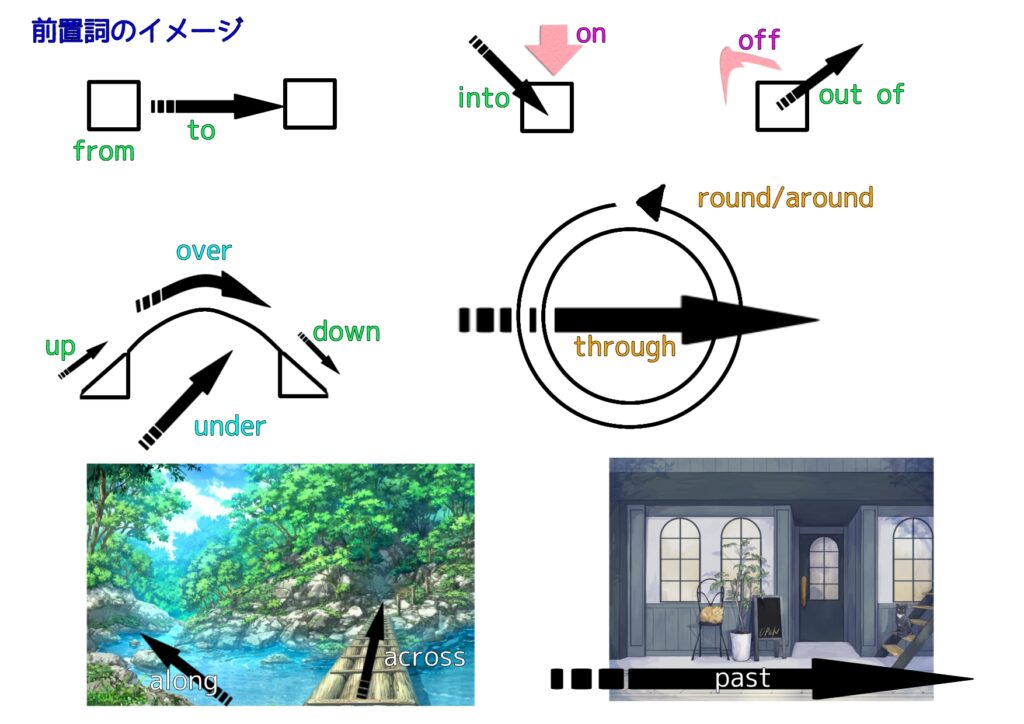第88回:前置詞が表す意味と使い方(位置・移動を表す前置詞)

細かい言葉の使い方だったり、違いになりますが、このあたりの知識を正確に理解して使えるようになると、ネイティブレベルの英語の使い手になれます!
Q. この記事で、一番大事なことって何?
A. 大事なことを、1枚の画像にまとめました。

いちいちノートにまとめるのが面倒だという方、また、
ノートにまとめることが苦手だという方は、ご活用ください。

[広告]
確かな英語力は、日々の継続から。
その継続を後押しする、第二言語習得理論に基づいた
オンライン英語学習プログラムがあります。
英語を使う人のための、確実なスキルアップが望める
7日間の無料体験はこちらから!

位置と移動を表す前置詞
- Across, over
・道路、橋、国境、川などの反対側の位置や、反対側に移動することについて話すために、acrossまたはoverを使用できます。
例)Antonio lives in the house across / over the road from ours.(アントニオは、私たちの家の向かい側の家に住んでいます。)
例)Once she was across / over the border, she knew she would be safe.(彼女が国境を越えると、安全になることを知っていました。)
・何かの反対側に到達する場合は、高いもの、または幅よりも高いものを使ってoverを使用します。
例)He jumped over the fence into the garden.(彼はフェンスを飛び越えて庭に入った。)
例)He jumped across the stream.(彼は小川を飛び越えた。)
・平らな表面や国や海などの領域など、平面とみなされるものや領域について話す場合、通常はoverよりもacrossを使用します:
例)He suddenly saw Eva across the room.(彼は突然、部屋の向こう側にエヴァを見かけました。)
例)The programme was broadcast across Canada.(その番組はカナダ全土に放送されました。)
・ある領域の多くの異なる部分に対しては、all overをall acrossの代わりに使用します。ただし、強調のためにacrossまたはright acrossをよく使用します:
例)The disease has now spread all over the world.(その病気は現在、世界中に広がっています。)(または…(right)across the world.) - Along, through
・道路、川などの線に沿って移動する場合、alongを使用します:
例)They walked along the footpath until they came to a small bridge.(彼らは小道に沿って歩いて小さな橋にたどり着きました。)
・throughは、周囲に物がある三次元の空間での移動を強調するために使用されます。二次元の空間、平らな表面や領域ではなく、次のような移動を強調します
:He pushed his way through the crowd of people to get to her.(彼は人ごみを押しのけて彼女のもとに行きました。)
・throughはしばしば空間の片側または端からもう一方に移動することを示唆します。
例)She walked through the forest to get to her grandmother’s house.(彼女は祖母の家に行くために森を歩きました。)
例)She spent a lot of her free time walking in the forest.(彼女は多くの自由な時間を森で歩くことに費やしました。)
- Above, over; below, under; beneath, underneath
・ある物が別の物よりも高い位置にある場合、aboveまたはoverを使用できます。
例)Above/Over the door was a sign saying, ‘Mind your head’.(ドアの上には「頭に気をつけて」というサインがありました。)
・ただし、別のものの真上ではない場合は、aboveではなくoverを好みます。
例)They lived in a village in the mountains above the lake.(彼らは湖の上の山村に住んでいました。)(直接上にない)
例)The bird hovered just a few metres above / over the lake.(その鳥は湖のすぐ上を飛んでいました。)(直接上にある)
・何かが他の何かを覆い、接触している場合は、overではなくunderを使用します。
例)She put a quilt over the bed.(彼女はベッドにキルトをかけました。)
・また、水平な動きが何かを覆いながら高い位置にある場合は、通常overを使用します。
例)I saw the helicopter fly out over the water, near the fishing boat.(ヘリコプターが漁船の近くで水上に飛び出すのを見ました。)
・Belowはaboveの反対であり、underはoverの反対です。belowとunderの使用における違いは、aboveとoverの使用における違いと似ています(上記参照):
例)It’s hard to believe that there is a railway line below / under the building.(建物の下に鉄道があるとは信じがたい。)(より低い位置に)
例)Her head was below the level of the table so nobody noticed her.(彼女の頭はテーブルの高さ以下だったので、誰も彼女に気づきませんでした。)(直接下ではない)
例)She hid the presents under a blanket.(彼女はプレゼントを毛布の下に隠しました。)(毛布はプレゼントを覆い、接触している)
例)Zara ran under the bridge.(ザラは橋の下を走りました。)(より低い位置での水平移動)
・場所の前置詞として、underneathはunderの代わりとしてより形式的に使用されることがあります。
具体例
- Across, over:
- She walked across/over the bridge to reach the other side of the river.
- The children ran across/over the road to get to the park.
- Once he was across/over the border, he felt a sense of relief.
- Along, through:
- They cycled along the coastal road, enjoying the beautiful views.
- She made her way through the dense forest, navigating through the trees.
- They walked along the narrow path, following the river’s course.
- Above, over; below, under; beneath, underneath:
- The plane flew over the mountains, offering breathtaking views.
- The kite soared above the beach, dancing in the wind.
- The treasure was hidden beneath/underneath the old oak tree.
- She found her keys under the pile of papers on her desk.
- The cat curled up underneath the blanket for a nap.
- The diver explored the underwater world below the surface of the ocean.
Please note that these examples are fictional and created for illustrative purposes.
[広告]
TOEICのスコアを上げたいけれど、
まとまった勉強時間が取れなくて困っている…
なら、細かいスキマの時間を使いながら、
少しずつスキルを積み重ねてみてはどうでしょう。
スマホ1つでスコアアップが出来る、
オンライン講座のリンクはこちらから。

Q. この文法はどうやって使うのでしょうか?
A. 今回の文法を活用した会話文を見てみましょう。

Where does John live?
(ジョンはどこに住んでるの?)

He lives in the house across the road from ours.
(彼は私たちの向かい側の道路の家に住んでるよ。)

Oh, I see. So, it’s just over the road then?
(なるほど。だから、道路の向こう側ってこと?)

Yes, exactly. It’s right over the road, not far from here.
(そう、まさにその通りだよ。ここからすぐ向こう側の家だよ。)

That’s convenient. And what about Lisa? Is she still living in the apartment above the bakery?
(それは便利だね。じゃあ、リサはどうなの?彼女はまだパン屋の上のアパートに住んでるの?)

No, she moved. She now lives in an apartment over the new shopping mall downtown.
(いや、彼女引っ越したんだ。今はダウンタウンの新しいショッピングモールの上のアパートに住んでるよ。)

Ah, I didn’t know that. I thought she preferred living above the busy streets.
(ああ、そうなんだ。彼女は賑やかな通りの上に住むのが好きだと思ってたよ。)

Well, this new apartment offers a great view of the city skyline, so she decided to move there.
(まあ、この新しいアパートは街の景色が素晴らしいから、彼女はそこに引っ越すことにしたんだよ。)

That sounds lovely. I should visit her and see the view from up there.
(それは素敵だね。彼女を訪ねて、そこからの景色を見てみるべきだな。)

You definitely should. It’s breathtaking, especially at night.
(絶対にね。特に夜は息をのむほど美しいよ。)
[広告]
ロゼッタストーン・ラーニングセンターで、最先端の教育制度を活用して英語を学びませんか?私たちは個々の学習ペースに合わせてeラーニングと対面教育を組み合わせ、柔軟な学習環境を提供しています。自宅でのeラーニングと対面教育のメリットを最大限に活かし、あなたの英語学習をサポートします。最新のテクノロジーと個別の指導が組み合わさった当センターで、自由な学習スタイルを体験してみませんか?英語学習を楽しく効果的に進めるための環境がここにあります。新たな一歩を踏み出して、新しい英語学習の旅に参加しましょう!

Q. この記事の要点は?
A. 前置詞の使い方を確認しました。
Prepositions of Position and Movement:
- Across, Over:
- Used to talk about a position on the other side of or moving to the other side of a road, bridge, border, river, etc.
- Over is used for reaching the other side of something high, while across is used for flat surfaces or areas.
- Along, Through:
- Along is used when following a line, such as a road or river.
- Through emphasizes movement in a three-dimensional space with things all around.
- Above, Over; Below, Under; Beneath, Underneath:
- Above and over are used to indicate a higher level, but over implies direct contact.
- Over is used when something covers and touches another thing.
- Below and under are opposites of above and over, with similar usage patterns.
- Underneath can be used as an alternative to under, while beneath is a more formal alternative.
Note: “All over” is preferred over “all across” to mean ‘in many different parts of an area,’ but “across” can be used for emphasis.
英会話を始めてみたいけれど、どのサービスが良いか分からない…
そんな方は、まず、この記事で3つのサービスを比べてみてはいかがでしょうか?
英語力を効率良く伸ばすことができるサービス3選です。

次回の文法解説は?
「〇〇の間」を表す言葉。
この記事を作る際に参考にした文法の解説書になります。
すべて英語で書かれていますが、練習問題が付いてます。
イギリス英語なので、スペル等の表記が異なる部分もありますが、
「使い方を練習したい」「繰り返し問題を解きたい」
という方は、使ってみても良いかもしれません。

関連記事一覧
他の文法解説記事を検索できます。







-320x180.jpg)




コメント